It seemed like a recipe for failure: 14 academically-struggling young men, at the end of a long day of school, being asked to study ancient religious texts. How was I going to get any meaningful learning done with this group? The answer to this question came from the best place possible, the kids themselves. They explained to me quite simply, “97% of what you teach us, we don’t actually learn.” It was with these words that my 16-year old students taught me one of the most important lessons that I have ever learned as an educator. While I prepared countless lessons and curricula over my years as an educator in a conventional school, what I failed to realize was that what I was teaching and what they were learning were often worlds apart. The mind of a young person, particularly someone who is considered to have autism spectrum disorder (ASD), dyslexia, or attention-deficit/hyperactivity disorder (ADHD), processes information on their own terms, and my best attempts to reach them, my way, were all futile.
What these young people taught me was that my notion of a disorganized classroom that would have gotten poor reviews in graduate school, namely kids moving around, jumping from topic to topic, and sharing personal stories, was actually the most meaningful form of learning for them. It is the art of allowing for self-direction in a conventional classroom that I am now trying to master, and quite a challenge it is. To somehow teach the subject at hand while respecting the personalities, interests, and learning style of everyone in the class has become the challenge. When a student asks a question that is not on topic, do I view it as a distraction or recognize it as a learning opportunity and take advantage of their curiosity? Am I willing to allow students to take over the spotlight and direct the learning, while physically standing on the side myself? For me personally, I have shifted from teaching my planned lesson in a neat organized way, sometimes at the expense of the children’s feelings, to putting them in the center, and striving to give them every opportunity to succeed, whatever that might look like.
After spending so many years reviewing, developing, designing, and refining curricula for myself in my classroom, I have come to embrace the fact that real learning happens on its own terms. Some things in life can be scripted and planned in advance. Reading a “how-to” guide can tell you how to install a new appliance or build a piece of furniture, but the fact is that real learning and understanding takes a different path. On any given day, I do not know what state my students are in. What are their joys and struggles? Do they feel loved and welcome, or threatened and pressured? I do not know what kind of smudges are on their glasses. I can present ideas and explain material, but ultimately the learning that they do is their own.
The fact is that when we have a room full of people, each full of their own experiences, personalities, and learning styles, we also have a room full of diverse perspectives. Even without remote learning or pandemic-induced societal pressures, differences in learning experiences for different kids always have been, and always will be, very real. The experience of learning a math equation by a child who is amazed and enthralled by the beauty of mathematics is completely different from that of the child, uninterested in mathematics, who is almost done composing his very own song and is reviewing the last verse over and over again in his head. The self-direction that takes place in all types of learning is quite clear once we learn to look for it.
This concept reminds me of a notion I was taught early in my teaching career. While listening to a presentation by an author of a highly successful history curriculum used by thousands of students in hundreds of schools, he noted that the whole notion of creating such a curriculum has a certain, inherent flaw. In his words: “learning is sloppy.” Indeed. In his article entitled “Twilight of the Lecture“, Craig Lambert describes how Professor Eric Mazur of Harvard University discovered how perceived “chaos” can in fact be the sign of authentic learning in action. Students sitting and listening to a lecture might appear to be effective teaching, but in fact far more learning happens when they are given the freedom to explore the ideas in their own way. on their own. Some students will immediately connect to what the teacher is saying, while others will not. Some will need to spend time reading, others listening, others will not appreciate the subject until they do their own research and presentations, and some are just not there yet or are not interested in that particular topic. The process cannot and should not be as smooth and easy as a curriculum implies. We must embrace the dynamic nature of learning (and life in general). Learners must be allowed to question and search to figure things out. We must allow children to fail and try again in order to truly learn. Changing course is not a sign of a failed curriculum, but rather a sign of genuine learning in action. Lack of predictability means that each child is in fact self-directing and has been given the time and space that they need to learn in a way that is genuine and real.
Similarly, so many “learning disabilities” are in fact styles of self-directed learning that are not fully appreciated. In a TED Talk entitled, “ADHD sucks, but not really,” Salif Mahamane describes the various traits of people with ADHD, and all of the adaptive values that they have. He describes our society as one that is “pro-uniformity” and hence unable to truly embrace the self-direction of people who think differently. People with ADHD, dyslexia, and autism, for instance, have styles of self-direction and relatedness that are quite different from others, and it is incumbent upon the rest of us to make a place for them at the table as well.
The learning that people do will indeed be their own, but it is up to educators to provide the conditions in which they can travel the road of self-discovery. We must make available to them wisdom and opportunities, and watch the magic of learning unfold in its own diverse, sloppy, and beautiful way.
So it seems that in fact it is quite impossible for learning NOT to be self-directed. People can teach unwilling students, but ultimately the learning of those students will be based on factors within themselves. When we learn to embrace self-direction under all circumstances, children will feel welcome and accepted and embrace their unique journey.
If you enjoyed this article and feel called to give back to ASDE, here are ways you can support our work:
- Donate money
- Share our content with others! Click one of the buttons above to easily share on Twitter, Facebook, or email.
- Consider becoming a Contributor for Tipping Points
Tipping Points Magazine amplifies the diverse voices within the Self-Directed Education movement. The views expressed in our content belong solely to the author(s). The Alliance for Self-Directed Education disclaims responsibility for any interpretation or application of the information provided. Engage in dialogue by reaching out to the author(s) directly.






